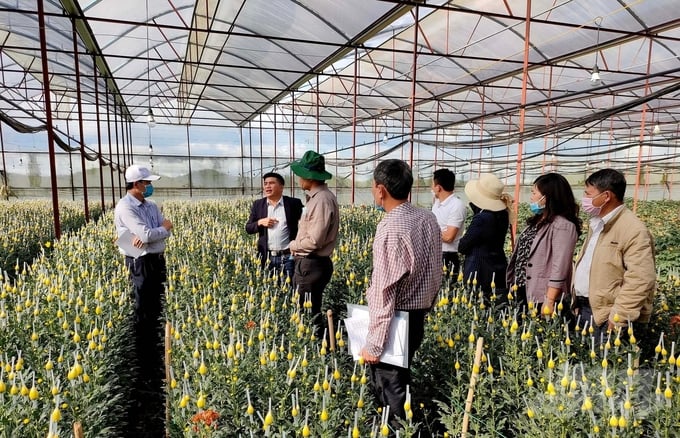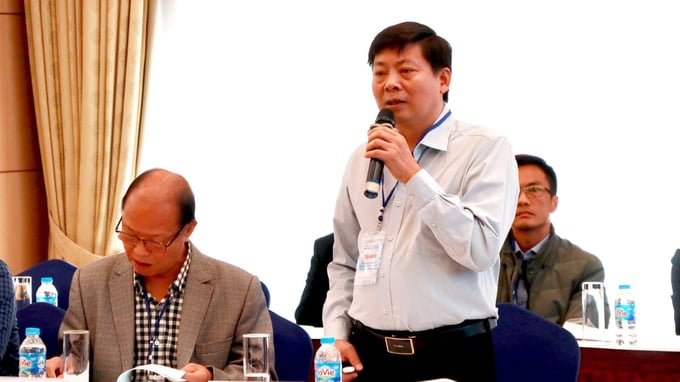April 13, 2025 | 23:25 GMT +7
April 13, 2025 | 23:25 GMT +7
Hotline: 0913.378.918
April 13, 2025 | 23:25 GMT +7
Hotline: 0913.378.918

The lack of regulations for greenhouse development in Lam Dong has resulted in several greenhouses encroaching on forest land and protective corridors for infrastructure, negatively impacting urban aesthetics and landscape. Photo: TL.
Lam Dong province's Department of Agriculture and Rural Development recently organized a workshop on managing greenhouses in climate-resilient agricultural production. Accordingly, the workshop aimed to identify planning, management, and development solutions for greenhouses that combine agricultural production objectives and urban development goals while developing the environmental landscape towards green and sustainable urban agriculture.
On the other hand, the Department is effectively implementing a greenhouse management project that promotes high-tech, climate-resilient agricultural production by 2030, as set forth by the Lam Dong Provincial People's Committee.
According to the Lam Dong province's Department of Agriculture and Rural Development, the total greenhouse area in the province reached over 5,600 hectares by the end of the first quarter of 2024. Notably, Da Lat city accounted for over 50% of this area, with more than 2,900 hectares, followed by Duc Trong district with 317 hectares, Don Duong district with 450 hectares, and Lac Duong district with 1,648 hectares.
The recent trend of organizations and farming households developing greenhouses, in combination with the application of scientific and technological solutions and high-tech equipment in agricultural production, is primarily driven by the higher economic returns compared to the open-field cultivation of similar crops.

Flower farming in greenhouses generates a production value ranging from 1.6 to 1.8 billion VND per hectare per year. Photo: PC.
Nguyen Van Chau, Deputy Director of Lam Dong province's Department of Agriculture and Rural Development, reported that with the province's efforts to develop high-tech agriculture (particularly in Da Lat city and the districts of Lac Duong, Don Duong, and Duc Trong), greenhouses have become a prioritized technical solution for local farmers, businesses, and cooperatives. Additionally, this infrastructure supports the integration of other high-tech solutions for agricultural production.
A survey conducted by the Lam Dong province's Sub-Department of Crop Production and Plant Protection on various vegetables and flowers cultivated in greenhouses in Da Lat revealed the following: both fertilizer and pesticide usage reduced by 30% for spinach cultivation; fertilizer usage reduced by 36% and pesticide by 50% for rose cultivation; fertilizer usage reduced by 40% and pesticide by 50% for strawberry cultivation. Furthermore, the cultivation of vegetables and flowers in greenhouses reduces irrigation water and fertilizer usage by 30% and pesticide costs by 50%.
Consequently, high-tech greenhouse production has generated substantial revenue for multiple local businesses and farmers. Depending on the type of vegetable or flower, integrating greenhouses with high-tech solutions can potentially increase productivity by 2 to 3 times and the value of agricultural products by 1.5 to 2 times compared to open-field cultivation.
However, according to Deputy Director Chau, despite the economic benefits of greenhouse technology, its unregulated development has resulted in several issues. Notably, several greenhouses have encroached on forest land and protective corridors for infrastructure (transportation, irrigation, historical sites, cultural landmarks, and security and defense zones), negatively impacting urban aesthetics and landscape.

At present, three regions within Lam Dong province have issued plans for managing greenhouses and promoting high-tech, climate-resilient agricultural production by 2030. Photo: PC.
However, the installation of greenhouses at a high construction density without allocating spaces for outdoor production, green areas, and drainage systems has negatively impacted the landscape and environment. Consequently, this issue has hindered rainwater absorption and contributed to flooding in several regions.
Deputy Director Chau Chau added that the application of greenhouse technology and intensive farming solutions has also limited biodiversity, reduced natural predator populations, and damaged the natural microbial ecosystem.
On the other hand, Associate Professor Dr. Mai Van Trinh, Director of the Institute of Agricultural Environment (Vietnam Academy of Agricultural Sciences), purported that greenhouses in Da Lat are an inevitable aspect of the city's agricultural development trajectory and the broader growth of Lam Dong province. They represent a form of smart agriculture that adapts to climate change, attracts investment, and promotes tourism.
Associate Professor Dr. Mai Van Trinh also suggested Da Lat and the agricultural sector in Lam Dong province to develop greenhouses with comprehensive and landscape planning, integrating tourism with smart agriculture, high-tech agriculture, ecological farming, and experiential agriculture to create added value.

Associate Professor Dr. Mai Van Trinh recommended the agricultural sector in Lam Dong to develop greenhouses with comprehensive and landscape planning. Photo: VL.
Regarding the flower production industry, Lai The Hung, Vice President of the Da Lat Flower Association, expressed concerns regarding the future reduction of greenhouses within Da Lat city. He cited a major difficulty in selecting suitable outdoor flower species and varieties (after dismantling greenhouses) due to a lack of adaptable seeds, production processes, and a need to expand the cultivation area to protect farmers' livelihoods. On the other hand, the local agricultural sector is unable to clearly establish a production and consumption chain as well as a market. To date, the city has primarily focused on ornamental flowers with low demand and market value, which further challenges the expansion of cultivation areas.
Additionally, the relocation of greenhouses poses a significant challenge, as farmers lack land in the suburbs of Da Lat. As a result, they only have the option of dismantling greenhouses as scrap. Greenhouses are a substantial investment for farmers, valued at 2 to 3 billion VND per hectare (including loans and long-term depreciation). Without a site for relocation, dismantled greenhouses face the risk of becoming valueless scrap.
In response to feedback from experts, scientists, businesses, and residents, Deputy Director Nguyen Van Chau stated that the Department will submit all received recommendations to the Lam Dong Provincial People's Committee. This initiative will facilitate the effective implementation of the greenhouse management project and the promotion of high-tech, climate-resilient agricultural production by 2030.
To date, three regions within Lam Dong province, namely Da Lat city, Lac Duong district, and Don Duong district, have issued plans for managing greenhouses and promoting high-tech, climate-resilient agricultural production by 2030. These plans outline detailed solutions in accordance with the provincial project. Among these solutions, reducing greenhouse area in urban spaces requires the complete removal of all unauthorized greenhouses. So far, the province has cleared and relocated 105 hectares out of the 134 hectares of unauthorized greenhouses on forest land.
Translated by Nguyen Hai Long

(VAN) The results from pilot fields are catalyzing the expansion of the One million hectares of high-quality, low-emission rice project in Kien Giang.

(VAN) On the morning of April 11, Cuc Phuong National Park received 18 individuals of endangered and rare wild animals from Da Nang city.

(VAN) FAO supports Vietnam in enhancing survey sampling techniques for the 2025 nationwide agricultural and rural census.

(VAN) By participating in the green transition, manufacturers become an indispensable part of the circular economy, contributing to resource optimization and environmental protection.

(VAN) The One Million Hectares of High-Quality and Low-Emission Rice Program can generate nearly 14 million tons of straw annually, posing an urgent requirement to diversify straw-based products.

(VAN) This figure was recently announced at a conference held in Yen Bai, focusing on climate-resilient infrastructure development for ethnic minority regions.

(VAN) The evacuation center is a practical work in efforts to respond to natural disasters and adapt to climate change in vulnerable areas.